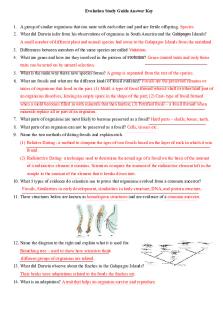Tissues study guide KEY 2019 2 PDF

| Title | Tissues study guide KEY 2019 2 |
|---|---|
| Author | Amna Aaa |
| Course | Human Anatomy and Physiology 1 |
| Institution | University of Houston |
| Pages | 3 |
| File Size | 106.3 KB |
| File Type | |
| Total Downloads | 67 |
| Total Views | 165 |
Summary
Study guide for tissues unit with answer key...
Description
Anatomy and Physiology: Study Guide (TISSUES) Epithelia tissue: 1. What are four characteristics of epithelia? 1. Cells bound closely together 2. Has a free surface (apical) exposed to the environment or to some internal chamber or passageway 3. Attached to underlying connective tissue by a basement membrane 4. Absent of blood vessels: avascular 2. What are four functions of epithelia? 1. Provide physical protection 2. Control permeability 3. Provide sensation 4. Produce specialized secretions (glands) 3. Describe the basement membrane. - Lies between epithelium and underlying connective tissue - Consists of network of protein fibers - Acellular - Functions - provides strength and resists distortion - provides a barrier that restricts movement of large molecules from underlying connective tissue into epithelium 4. Why must epithelia be continually repaired? How is it repaired? Epithelia must be continually repaired because it physically protects the tissues underneath it. It is repaired by stem cells lying near the basement membrane. 5. How do we classify epithelia? By the number of layers and the cell shape 6. Give the function of each epithelia type listed below and give an example of where it is found: A. Simple squamous: diffusion, lungs B. Endothelium: lining of hollow organs C. Mesothelium: lining of internal cavities and organs D. Simple cuboidal: secretion/absorption, glands/stomach/intestines/bile duct E. Simple columnar: protection/absorption/secretion, digestive tract F. Stratified squamous: protection, mechanical stress G. Stratified cuboidal: protection, sweat and salivary glands H. Stratified columnar: protection, mammary glands/larynx/urethra in males I. Pseudostratified columnar: secretion/protection/mucus, respiratory passageways J. Transitional: protection/permeability/sensation, bladder/uterus
Connective tissue: 1. What three components do all connective tissues have? 1. specialized cells 2. protein fibers 3. ground substance 2. Explain the difference between “blast” and “cyte” cells. Blast cells: immature cells that create the matrix of the connective tissue Cyte cells: mature cells that maintain the matrix after it is created They are the same cells – they just have different names depending on what stage they are in. 4. For the connective tissues listed below, give an example of where they can be found: A. Areolar: underneath (deep to) epithelia B. Adipose: within abdomen C. Reticular: white blood cells D. Dense regular: tendons/ligaments E. Dense irregular: dermis 5. Describe cartilage. - Main cell type is chondrocyte - Extracellular matrix is dense collagen; almost solid, very rigid - Avascular (no blood vessels; torn cartilage won’t heal). 6. Describe bone. - Extracellular matrix is solid, full of minerals (instead of fluid) - Minerals are: Calcium carbonate and Calcium phosphate (same as limestone) - Main cell type is osteocyte = “bone” cells in lacunae - Well vascularized 7. Which type of cells are in blood? Red blood cells (erythrocytes), white blood cells (leukocytes), platelets 9. Describe an erythrocyte and a leukocyte. Erythrocytes: Biconcave disk, large surface area, very flexible, not “true” cells (no nucleus), sacs of hemoglobin Leukocyte: Recognizes specific foreign molecules, destroys pathogens effectively Muscle tissue: 1. Describe where each of the following types of muscle are found. A. Skeletal muscle: attached to skeleton B. Cardiac muscle: only in heart C. Smooth muscle: digestive system, bladder, uterus 2. What are striations? Striations are stripes on skeletal muscle and cardiac muscle formed from certain arrangements of proteins within the muscle.
3. What is the difference between voluntary and involuntary? Voluntary is controlled consciously; involuntary is not.
Neural tissue: 1. Which structures are made of neural tissue? Brain, spinal cord, nerves 2. What do the support cells do? Monitor chemical composition of neural tissue...
Similar Free PDFs

Tissues study guide KEY 2019 2
- 3 Pages

Study guide key
- 8 Pages

Test4Review KEY - Study Guide
- 4 Pages

Macroe Study Guide Key
- 18 Pages

Quiz 2 Study Guide & Answer Key
- 4 Pages

Med Surg 2 Study Guide Answer Key
- 145 Pages

Exam 2 study guide Fall 2019
- 5 Pages

Stats Study Guide Answer Key
- 5 Pages

Chapter 3 Study Guide Key
- 39 Pages

Evolution Study Guide Answer key
- 2 Pages

2019 FRM Study Guide Changes
- 13 Pages

ATI Nutrition 2019 - Study Guide
- 12 Pages

Final Study Guide Fall 2019
- 4 Pages

Tissues Review Guide-Filled out
- 8 Pages

5 Tissues Review Guide 2021
- 2 Pages
Popular Institutions
- Tinajero National High School - Annex
- Politeknik Caltex Riau
- Yokohama City University
- SGT University
- University of Al-Qadisiyah
- Divine Word College of Vigan
- Techniek College Rotterdam
- Universidade de Santiago
- Universiti Teknologi MARA Cawangan Johor Kampus Pasir Gudang
- Poltekkes Kemenkes Yogyakarta
- Baguio City National High School
- Colegio san marcos
- preparatoria uno
- Centro de Bachillerato Tecnológico Industrial y de Servicios No. 107
- Dalian Maritime University
- Quang Trung Secondary School
- Colegio Tecnológico en Informática
- Corporación Regional de Educación Superior
- Grupo CEDVA
- Dar Al Uloom University
- Centro de Estudios Preuniversitarios de la Universidad Nacional de Ingeniería
- 上智大学
- Aakash International School, Nuna Majara
- San Felipe Neri Catholic School
- Kang Chiao International School - New Taipei City
- Misamis Occidental National High School
- Institución Educativa Escuela Normal Juan Ladrilleros
- Kolehiyo ng Pantukan
- Batanes State College
- Instituto Continental
- Sekolah Menengah Kejuruan Kesehatan Kaltara (Tarakan)
- Colegio de La Inmaculada Concepcion - Cebu
